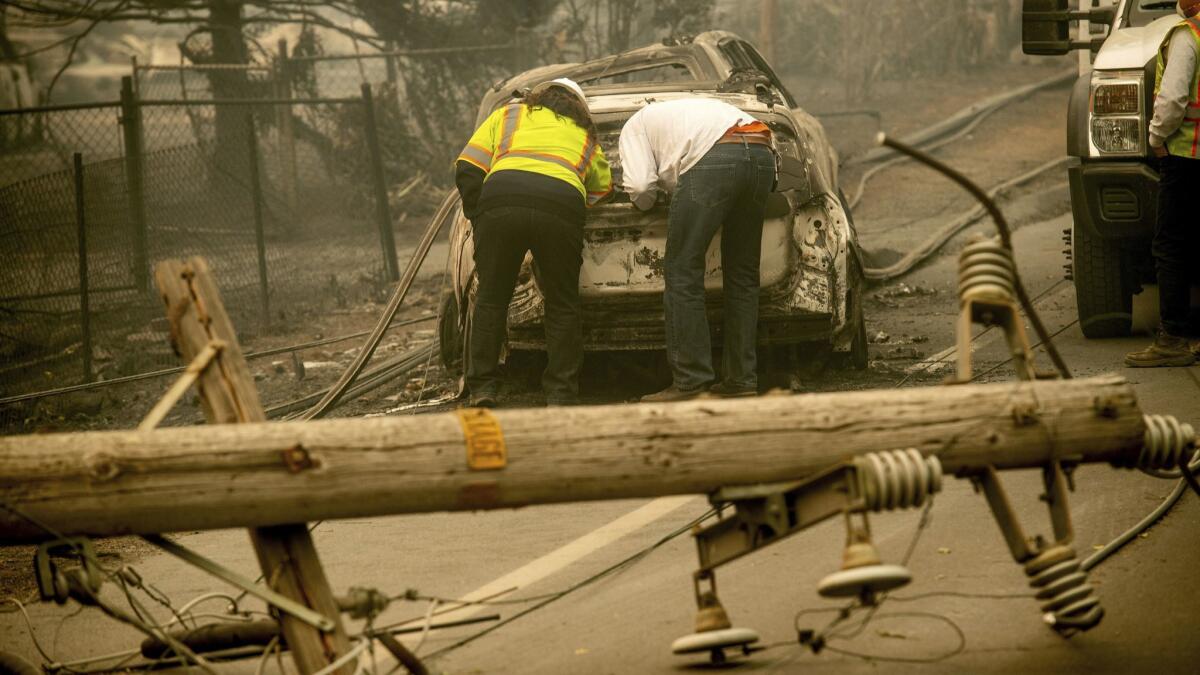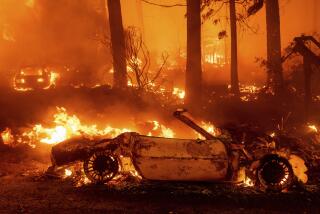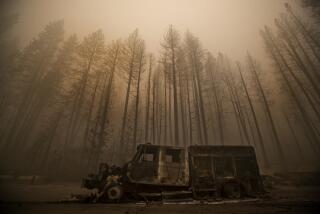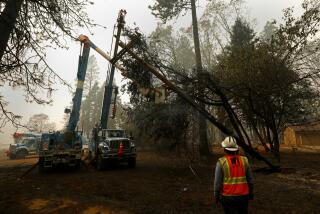PG&E stock, bonds plunge anew as S&P cuts its credit rating to junk

PG&E Corp. shares continued plunging and bonds dropped to all-time lows Tuesday after S&P Global Ratings slashed the utility company’s credit grades to the middle of the junk spectrum from investment grade, citing its limited options for managing wildfire liabilities.
The company’s shares finished the day down $1.39, or 7%, to $17.56, as investors worried about the potential for the company to file for bankruptcy. On Monday, shares fell 22%. California investigators are looking into whether Pacific Gas & Electric Co. equipment ignited the deadliest blaze in state history in 2018 as well as fires in 2017, investigations that could leave the company with legal liabilities topping $30 billion.
S&P cut the company’s rating five levels to B, the fifth-highest junk rating, from BBB-, the lowest investment-grade level, according to a statement late Monday. More cuts may come, it said. Fitch Ratings and Moody’s Investors Service still rate the company at investment grade.
A spokesman for PG&E said in an email Tuesday the company’s board was “actively assessing” operations, finances, management, structure and governance while maintaining a commitment to improving safety.
California looks to electricity shutoffs as a faster, cheaper wildfire solution »
PG&E’s record-low bond prices underscore how much more the company will have to pay to borrow in the future — even if California comes up with a legislative bailout. It also highlights how vulnerable even highly regulated, traditionally dependable stocks such as utilities can be to wildfires, hurricanes and other natural disasters.
“This will ultimately increase costs to California ratepayers and taxpayers, which already face a high cost of living,” Gabriel Petek, an S&P analyst who rates the state of California, not PG&E, said in an email Monday. “The important takeaway to me is that these fires and how the ‘fire season’ is virtually a year-round phenomenon now represent a material consequence of climate change.”
PG&E’s notes due next year with a coupon of 3.5% are yielding more than 9.9%, a level far above what most high-yield securities are paying. Debt rated B, for example, the mid-tier of junk bonds, yields on average 7.5% as of Monday’s close, according to Bloomberg Barclays index data.
Moody’s and Fitch have the company under review for further cuts. The firms started cutting in November as PG&E faced potential liabilities from 2017’s wildfires that could top $17 billion, according to a JPMorgan Chase & Co. estimate. The company had about $430 million of cash on its books at the end of September.
If Moody’s follows with a cut to high-yield as well, PG&E may face a cash collateral requirement of at least $800 million to guarantee power contracts, according to a regulatory filing. No other ratings triggers have been disclosed.
PG&E has suspended its dividend and fully drawn its lines of credit. It is considering filing for bankruptcy as soon as February, people familiar with the situation said Friday. State lawmakers and regulators are looking at options including allowing the company to issue bonds to pay its liabilities or breaking up the utility.
What would happen if PG&E sold its gas business or filed for bankruptcy? »
If PG&E is ultimately held responsible for the Camp fire, it could be on the hook for billions of dollars of potential liabilities. Because the company has filed for bankruptcy before, it and lawmakers would probably try to avoid a repeat, said Ryan Brist, head of global investment-grade credit and portfolio manager at Western Asset Management.
“That was a disastrous time for all participants involved,” Pasadena-based Brist said. “It would be my guess that the same parties would want to pursue a much less volatile solution this go-round when faced with the tough problems of statewide wildfires.”
But PG&E, with about $18.6 billion of long-term debt as of the end of September, could possibly see good reason to file for bankruptcy, CreditSights analyst Andy DeVries said in a report Monday. Such a filing would give the company bargaining power with insurance companies as it tries to settle customer claims at a discount, he said.
Fitch analyst Philip Smyth said a determination by California regulators that PG&E’s equipment was involved in the Tubbs fire in 2017 or last year’s Camp fire would be the strongest impetus to cut the rating.
“Right now, there is no investigation that says with any clarity … that their equipment was the catalyst,” Smyth said in an interview Monday. “Since we downgraded in November, I don’t think things have gotten meaningfully worse.”
More to Read
Inside the business of entertainment
The Wide Shot brings you news, analysis and insights on everything from streaming wars to production — and what it all means for the future.
You may occasionally receive promotional content from the Los Angeles Times.










